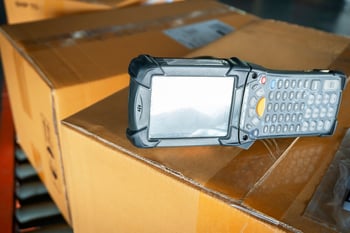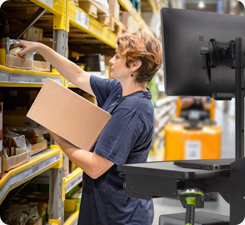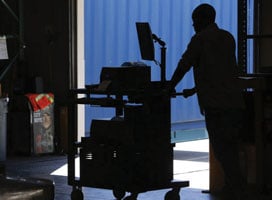
Deep dive into the ways that powered carts can make distribution centers more efficient, reducing the footsteps, the footprint in the workspace, and the cycle times, as well as issues related to mislabeling and excess payroll spend.
Warehouses and distribution centers are busy and strenuous environments. While many of these facilities are adopting technology to address challenges and improve efficiency, not all solutions are alike. In fact, one study found that there is a nearly 20% device failure rate in warehouses due to excessive daily use, proximity to heavy machinery, and other similar stresses. Here are some of the ongoing challenges distribution centers face and the ways powered carts are transforming work in these environments.
Ongoing Challenges Facing Distribution Centers
Warehouses and distribution centers have been facing unprecedented challenges for the past several years. At the same time, consumer demand has been soaring thanks to a rising interest in eCommerce, leading to delays and backlogs that impact a company’s performance. Some of the ongoing challenges facing distribution centers include:
Finding and Retaining Talent
 The biggest challenge these businesses face involves human capital. Hiring and retaining quality talent continues to be hard in an industry where workers tend to move laterally in search of better conditions. When workers are asked to perform repetitive tasks or aren’t given access to technology solutions that make work more efficient, they are likely to leave in favor of another employer.
The biggest challenge these businesses face involves human capital. Hiring and retaining quality talent continues to be hard in an industry where workers tend to move laterally in search of better conditions. When workers are asked to perform repetitive tasks or aren’t given access to technology solutions that make work more efficient, they are likely to leave in favor of another employer.
Inventory Management
Another major challenge involves inventory. Distribution centers struggle with a variety of things related to inventory, such as how much is needed, when it is received, how to store it effectively, and how long it takes to fulfill orders. When inventory sits too long in a warehouse, it can become obsolete or damaged. If there is no technology system in place to track what you have, you’ll never know what you need or be able to find the items when a customer places an order.
Errors and Damaged Items
Consumer demands have been soaring over the past several years, and warehouses are having a tough time keeping up. Whether it’s due to labor struggles, a lack of organization or a combination of the two, errors in order fulfillment are still too high. Either customers are sent the wrong items, or something happens during the fulfillment process, and items become damaged.
Efficiency and Productivity
 Because eCommerce sites have made online shopping so simple, many customers are making smaller orders more frequently. They also expect faster delivery times, however. Distribution centers are expected to operate like well-oiled machines. But many struggle to achieve the productivity and efficiency levels that will deliver an amazing customer experience and provide the best financial results for the business.
Because eCommerce sites have made online shopping so simple, many customers are making smaller orders more frequently. They also expect faster delivery times, however. Distribution centers are expected to operate like well-oiled machines. But many struggle to achieve the productivity and efficiency levels that will deliver an amazing customer experience and provide the best financial results for the business.
What Are Mobile-Powered Carts?
Mobile-powered carts are robust technology solutions built for the challenging environment of warehouses and distribution centers. A single mobile cart holds everything a worker needs to be productive, including a computer, monitor, label and barcode printers, wireless scanner, toolbox, and other workplace supplies.
The carts also come with maintenance-free batteries, inverters, and chargers that provide power for up to 12 hours, which is plenty for a full shift. A mobile workstation allows workers to perform their distribution center tasks wirelessly from any part of the facility.
How Powered Carts Are Transforming Distribution Centers
While organizations often think of technology innovation to mean things like high-end robots, fully autonomous vehicles, and artificial intelligence, there are other ways the supply chain can be modernized that don’t involve such drastic investments and changes. Here are some of the ways using powered carts are transforming distribution centers.
Improved Productivity
 Powered carts in warehouses can eliminate hundreds, if not thousands, of wasted steps between various warehouse sections and fixed computer workstations. When workers get mobile technology, they can complete tasks wherever they are located, allowing them to boost productivity. Specifically, workers no longer have to walk back and forth to get pick lists, packing lists, or printed shipping labels.
Powered carts in warehouses can eliminate hundreds, if not thousands, of wasted steps between various warehouse sections and fixed computer workstations. When workers get mobile technology, they can complete tasks wherever they are located, allowing them to boost productivity. Specifically, workers no longer have to walk back and forth to get pick lists, packing lists, or printed shipping labels.
By leveraging technology with mobile-powered carts, distribution centers can improve efficiency, reduce errors, and lower worker fatigue. Workers have the tools and information they need at their fingertips, which also improves job satisfaction.
Lower Cost Per Pick
 Order picking is one of the most time-consuming tasks in a warehouse. A worker must get a list of orders that require fulfillment and then physically go to the locations throughout the warehouse to “pick” those products off the shelves to be packaged and shipped.
Order picking is one of the most time-consuming tasks in a warehouse. A worker must get a list of orders that require fulfillment and then physically go to the locations throughout the warehouse to “pick” those products off the shelves to be packaged and shipped.
Having mobile carts on the warehouse floor can reduce the time it takes for picking, which also lowers the “cost per pick.” For example, instead of having to walk to a fixed location to get pick lists, a mobile cart can move through the warehouse with the worker. A worker can use these carts to achieve faster order picking and get more done with fewer resources.
Increased Order Accuracy
When a warehouse is run efficiently, there will be fewer errors in inventory management and order fulfillment. By minimizing worker footsteps, mobile carts reduce or eliminate many of the distractions that can lead to costly errors or carelessness. Workers have more time to devote to quality assurance, which also improves the customer experience.
Smaller Technology Footprint
Mobile-powered carts also permit a smaller technology footprint for a distribution center. For example, a traditional set-up requires workers to travel to a fixed technology center, such as an office that contains computer terminals and printers. Some warehouses have several of these. But mobile-powered carts can eliminate this need and free up that space for other uses, such as storing inventory.
Reduced Payroll Spend
One of the greatest challenges distribution centers face is attracting and retaining workers. Many companies are trying to find ways to do more with less. Mobile carts are the ideal solution as they improve efficiency and reduce unnecessary repetitive tasks. These gains can help companies reduce their payroll spend while they boost overall results at the same time.
Distribution centers have never been busier and have never faced so many challenges. By transitioning from fixed workstations to advanced solutions like mobile-powered carts, these businesses can save time, improve productivity, reduce errors, and allow workers to get more done with less.

